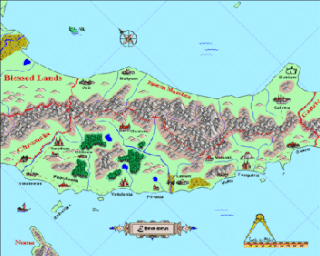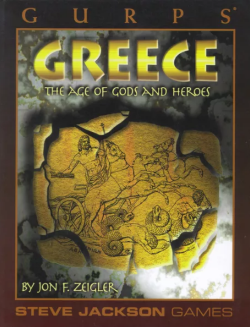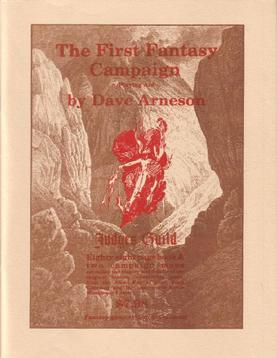
RuneQuest is a fantasy tabletop role-playing game originally designed by Steve Perrin, Ray Turney, Steve Henderson, and Warren James, and set in Greg Stafford's mythical world of Glorantha. It was first published in 1978 by The Chaosium. Beginning in 1984, publication passed between a number of companies, including Avalon Hill, Mongoose Publishing, and The Design Mechanism, before finally returning to Chaosium in 2016. RuneQuest is notable for its system, designed around percentile dice and an early implementation of skill rules, which became the basis for numerous other games. There have been several editions of the game.
The d20 System is a role-playing game system published in 2000 by Wizards of the Coast, originally developed for the 3rd edition of Dungeons & Dragons. The system is named after the 20-sided dice which are central to the core mechanics of many actions in the game.

Campaign Cartographer is a Windows map creation program created by ProFantasy Software originally in 1993.

The Player's Handbook is the name given to one of the core rulebooks in every edition of the fantasy role-playing game Dungeons & Dragons (D&D). It does not contain the complete set of rules for the game, and only includes rules for use by players of the game. Additional rules, for use by Dungeon Masters (DMs), who referee the game, can be found in the Dungeon Master's Guide. Many optional rules, such as those governing extremely high-level players, and some of the more obscure spells, are found in other sources.
Jeff Grubb is an author of novels, short stories, and comics, as well as a computer and role-playing game designer in the fantasy genre. Grubb worked on the Dragonlance campaign setting under Tracy Hickman, and the Forgotten Realms setting with Ed Greenwood. His written works include The Finder's Stone Trilogy, the Spelljammer and Jakandor campaign settings, and contributions to Dragonlance and the computer game Guild Wars Nightfall (2006).
Jenna Katerin Moran, previously known as Rebecca Sean Borgstrom and in early publications credited as R. Sean Borgstrom, is an American role-playing game (RPG) writer and designer, and novelist.

Star Wars: The Roleplaying Game is a role-playing game set in the Star Wars universe, written and published by West End Games (WEG) between 1987 and 1999. The game system was slightly modified and rereleased in 2004 as D6 Space, which used a generic space opera setting. An unrelated Star Wars RPG was published by Wizards of the Coast from 2000 to 2010. Since 2012 the official Star Wars role-playing game is another unrelated game, published by Fantasy Flight Games.
The flexibility of the Dungeons & Dragons (D&D) game rules means that Dungeon Masters (DM) are free to create their own fantasy campaign settings. For those who wanted a pre-packaged setting in which to play, TSR, Wizards of the Coast (WotC), and other publishers have created many settings in which D&D games can be based; of these, the Forgotten Realms, an epic fantasy world, has been one of the most successful and critically acclaimed settings. Many campaign settings include standard sword and sorcery environments, while others borrow Asian, Central American, swashbuckling, horror and even space-travel themes.

Role-playing games (RPGs) have developed specialized terminology. This includes both terminology used within RPGs to describe in-game concepts and terminology used to describe RPGs. Role-playing games also have specialized slang and jargon associated with them.

Dragon Warriors is a fantasy role playing game (RPG) system written by Dave Morris and Oliver Johnson and published by Corgi Books in 1985 and 1986. In 2009, it was re-collected in a new hardcover edition by Mongoose Publishing. This print run included the publication of several supplements to the Dragon Warrior's world "Legend". However, as of September 2010, this publication run had been discontinued but the books continue to remain available in PDF format.
A diceless role-playing game is a role-playing game which is not based on chance: it does not use randomisers to determine the outcome of events in its role-playing game system. The style of game is known as "diceless" because most games use dice as their randomiser; some games such as Castle Falkenstein use other randomisers such as playing cards as substitutes for dice, and are not considered "diceless".
GM – The Independent Fantasy Roleplaying Magazine was first published in September 1988 by Croftward Publishing. The editorial team of Tim Metcalfe, Paul Boughton and Wayne worked together previously on Computer and Video Games magazine.

Sean Patrick Fannon is an American role-playing game designer and writer. He has been working in the gaming industry since 1988, and is best known for his work with the Savage Worlds game system, including his epic fantasy setting, Shaintar, and his conversion of the classic game Rifts. He has also worked as a designer in the video game industry and a consultant in the film industry.

Ironclaw is a series of tabletop role-playing games created by Jason Holmgren of Sanguine Games, and features anthropomorphic characters in a setting inspired by class and religious conflicts during the Italian Renaissance. Jadeclaw is a related game in a concurrent East Asian setting.

Comme il Faut: All Things Right and Proper is a supplement published by R. Talsorian Games in 1995 for the fantasy steampunk role-playing game Castle Falkenstein.

GURPS Vampire: The Masquerade is a licensed adaptation of White Wolf Publishing's horror role-playing game Vampire: The Masquerade, written by Jeff Koke and published by Steve Jackson Games in 1993 for the third edition of their GURPS rules.

GURPS Greece is a supplement published by Steve Jackson Games (SJG) in 1995 for GURPS.

The First Fantasy Campaign is a supplement for fantasy role-playing games written by Dave Arneson and published by Judges Guild in 1977.

High Tech Enemies is a supplement published by Hero Games/I.C.E. in 1992 for the 4th edition of the superhero role-playing game Champions.













